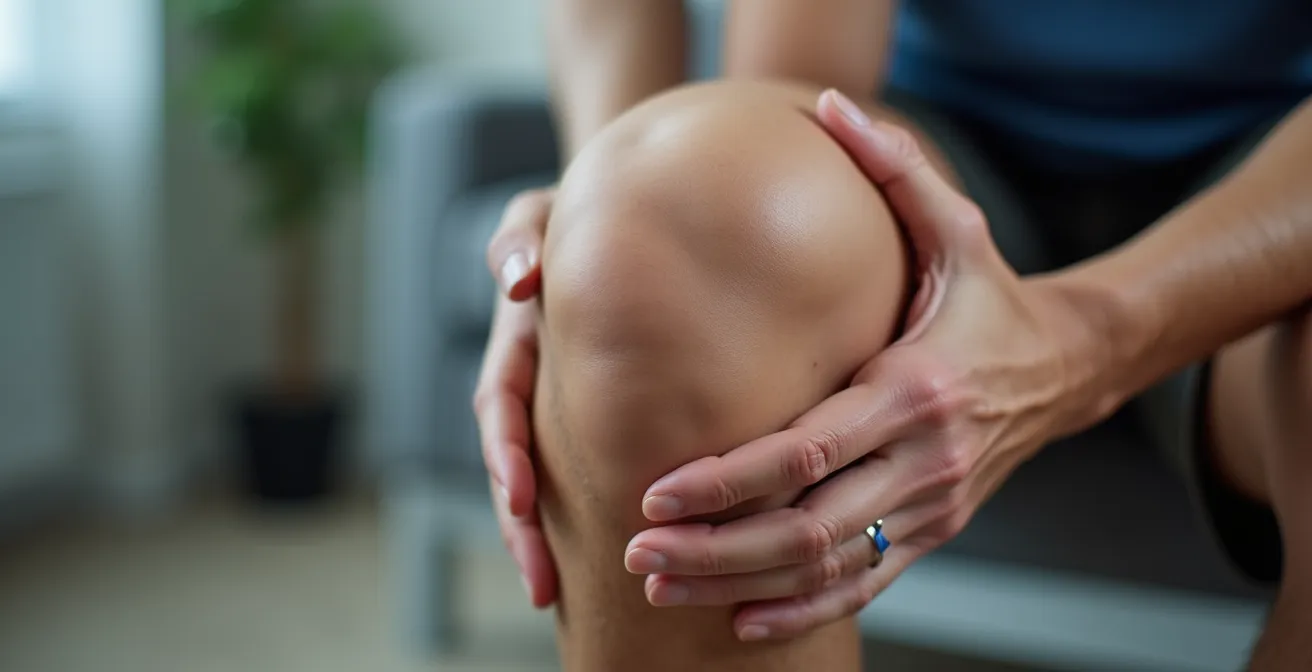
The question of what activities you can resume after a partial knee replacement is more than a simple checklist; it’s about starting a new partnership with your body. While timelines provide a framework, true recovery hinges on learning to interpret your knee’s new signals and rebuilding trust in its capabilities. This journey transforms recovery from a passive waiting game into an active process of rediscovering movement, guided by both clinical expertise and your own physical awareness. For those considering this procedure, understanding the nuances of a partial knee replacement by Pr. Etienne Cavaignac is the first step toward a successful outcome.
Your recovery roadmap in 4 key stages
- Phase 1 (Weeks 1-3): Focus on healing, pain management, and foundational movements with therapist guidance.
- Phase 2 (Weeks 3-8): Reintroduce low-impact exercises like stationary cycling and swimming to build strength.
- Phase 3 (Months 2-4): Gradually return to recreational activities and hobbies with necessary modifications.
- Phase 4 (Long-Term): Sustain mobility through consistent, smart exercise and specialist communication.
Decoding your post-surgery knee: A roadmap to regaining activity
The initial period following a partial knee arthroplasty (PKA) is a critical phase dictated by structured healing. Recovery isn’t a race but a series of deliberate steps. While many patients find their typical recovery timeframe for partial knee replacement is 3 to 6 weeks for resuming most daily activities, this progression is highly individual. Key physical indicators of readiness include diminished swelling, increased range of motion (ROM), and the ability to bear weight without significant pain. These signals, more than the calendar, tell you when your body is prepared for more.
Physical therapy is the cornerstone of this process, providing a controlled environment to challenge your new joint safely. A therapist’s guidance is indispensable for mastering fundamental movements and ensuring you don’t push too hard, too soon. Early rehabilitation begins almost immediately to kickstart this crucial journey.
Your rehab program, which includes range of motion exercises and knee extension and bending, will begin immediately after surgery.
– Advanced Orthopedic Center, Partial Knee Replacement Recovery: A Timeline
To safely navigate the first few weeks, a structured approach to rehabilitation is essential. The following steps provide a clear framework for what to expect and how to actively participate in your initial recovery phase.
Early Rehabilitation Checklist
- Manage pain and swelling carefully during the first 1-2 weeks.
- Practice walking with walking aids as advised, transitioning gradually to unassisted walking.
- Begin low-impact aerobic exercises such as stationary cycling after 3-6 weeks.
- Follow medical instructions on incision care and physical therapy.
This hands-on, guided approach is fundamental. The exercises introduced during physical therapy are designed not just to strengthen muscles but also to retrain your brain’s connection to your knee, a concept known as proprioception, which is vital for balance and stability.

Observing a therapist guide a patient through precise movements highlights the meticulous nature of early recovery. Each exercise has a specific purpose, from activating the quadriceps to restoring the knee’s ability to fully extend and bend, paving the way for more complex activities like walking and climbing stairs with confidence.
What are the first signs of a successful recovery?
The key early indicators are a noticeable reduction in pain and swelling, the ability to bear more weight on the leg comfortably, and a steady improvement in your knee’s range of motion during physical therapy.
Navigating the spectrum of activities: From gentle movement to recreational pursuits
Once you have a solid foundation, you can begin to broaden your range of activities. The key is a tiered approach, starting with exercises that strengthen the supporting muscles without placing undue stress on the new joint. Low-impact activities are the gateway to more dynamic pursuits, allowing you to build endurance and confidence safely.
Low-impact sports like swimming and cycling can often be resumed 6 to 8 weeks after surgery and are beneficial as they strengthen muscles without excessive joint stress.
– Professor Etienne Cavaignac, Resuming Activities and Driving After a Knee Replacement
Returning to hobbies like gardening, dancing, or golf requires not just physical readiness but also thoughtful modifications. This might involve using a garden stool to avoid deep kneeling, choosing gentler dance styles, or refining your golf swing to reduce rotational stress on the knee. Below is a comparison to help you distinguish between safe and potentially harmful activities.
| Activity Type | Examples | General Recommendation |
|---|---|---|
| Low-Impact (Recommended) | Swimming, Water Aerobics, Stationary Cycling, Walking, Elliptical Training | Excellent for building strength and endurance with minimal joint stress. Generally safe to resume within 6-12 weeks with medical clearance. |
| Moderate-Impact (Use Caution) | Doubles Tennis, Downhill Skiing (on groomed trails), Golf, Ballroom Dancing | May be possible after full recovery but require specific modifications and excellent muscle control. Discuss with your surgeon. |
| High-Impact (Generally Avoid) | Running, Basketball, Singles Tennis, Soccer, High-Intensity Interval Training (with jumping) | These activities can place excessive force on the implant, potentially accelerating wear and increasing risk of failure. Often discouraged long-term. |
Proprioception and balance training are especially important as you resume more complex movements. These exercises re-establish the communication pathways between your knee and your brain, improving your stability and reducing the risk of falls or stumbles, which is crucial for a safe return to an active lifestyle.

Aquatic therapy, as seen here, is an ideal environment for post-surgical rehabilitation. The buoyancy of the water supports your body weight, reducing impact on the joint while providing gentle resistance to help rebuild muscle strength and restore a natural gait pattern.
The mind-body connection in recovery: Cultivating patience and realistic progress
The physical journey of recovery is deeply intertwined with your mental and emotional state. It’s natural to feel frustration or impatience, especially if progress seems slow or you experience a minor setback. Acknowledging these feelings and developing coping strategies is a proactive part of the healing process. Setting realistic, incremental goals with your care team can transform a daunting long-term objective into a series of achievable victories.
As patient Rick Litavis noted in his story shared by Brigham and Women’s Hospital, the attitude of the care team provides a powerful boost: “‘Everybody was consistent and super friendly – that positive reinforcement makes you want to get to the next level.’” This highlights how a positive mindset, nurtured by a supportive environment, directly impacts physical healing and overall motivation.
Embracing a patient and positive outlook is a powerful tool. Here are some strategies to help manage the psychological aspects of your recovery and stay focused on your progress.
Strategies for Managing Recovery Frustrations
- Set achievable short- and long-term goals in consultation with your care team.
- Recognize and accept minor setbacks as part of the healing process.
- Practice patience and celebrate small milestones.
- Engage in regular communication with your physical therapist to adjust therapy.
Mindfulness and relaxation techniques can also play a significant role. Taking time to focus on your breathing or meditate can help manage post-operative discomfort and reduce the stress associated with the recovery journey, fostering a healthier environment for healing.

Cultivating moments of calm, as shown here, helps build mental resilience. This practice supports not only your psychological well-being but can also lead to better physical outcomes by reducing muscle tension and improving your focus during rehabilitation exercises.
Key Takeaways
- Recovery is a gradual process guided by physical signals like pain and swelling, not just a calendar.
- Start with low-impact exercises like swimming and cycling to safely rebuild strength around the joint.
- The mental aspect of recovery is crucial; cultivate patience and set realistic goals with your care team.
- Long-term success depends on consistent, modified exercise and open communication with your medical specialists.
Sustaining your renewed mobility: Long-term strategies and specialist insights
Achieving renewed mobility is a significant milestone, but sustaining it is the ultimate goal. The long-term health of your partial knee replacement depends on a continued commitment to smart, personalized exercise. This isn’t about returning to a pre-injury routine but rather adapting to a new normal that prioritizes joint preservation while enabling an active life. As experts note, this proactive approach is key to longevity.
Maintaining an active lifestyle with appropriate exercises is crucial for the health of your implant. According to the Florida Orthopaedic Institute, consistent low-impact activity helps extend the lifespan of the replacement and preserves function. This commitment to ongoing fitness is an investment in your future mobility and is fundamental to maintaining your overall well-being.
Regular check-ins with your orthopedic surgeon or physical therapist are vital. These appointments are opportunities to discuss your progress, address any concerns, and adjust your activity plan as your needs evolve. Clear communication ensures your routine remains both safe and effective for the long haul.
Understanding the mechanics of your implant underscores the importance of proper care. The device’s smooth articular surfaces are designed for fluid motion, but they benefit greatly from strong supporting muscles and the avoidance of high-impact forces that can cause premature wear. With the right strategy, you can enjoy your renewed freedom of movement for years to come. Now is the perfect time to plan your next active vacation and embrace your restored mobility.
Frequently asked questions on knee surgery recovery
How soon can I drive after a partial knee replacement?
The timeline for driving varies, but it’s typically between 2 to 6 weeks. It depends on which knee was operated on (right leg recovery takes longer for drivers in most countries), when you are no longer taking narcotic pain medication, and when you have regained sufficient muscle control to brake safely and suddenly.
Will my partial knee replacement set off airport security alarms?
Yes, it is very likely. Modern knee implants are made of metal alloys that will be detected by airport metal detectors. It’s a good idea to inform TSA agents about your implant before you go through screening to streamline the process.
What are the key differences in recovery between a partial and total knee replacement?
Recovery from a partial knee replacement is generally faster and less painful than a total knee replacement. Because the surgery is less invasive and preserves more of the natural knee, patients often experience a quicker return to normal activities, a better range of motion, and a more “natural” feeling knee.
Is it normal to hear clicking or popping sounds from my new knee?
Yes, mild clicking or popping sounds are common with knee implants and usually not a cause for concern. The sounds are typically caused by the metal and plastic components moving against each other. However, if the sounds are accompanied by pain or swelling, you should consult your surgeon.